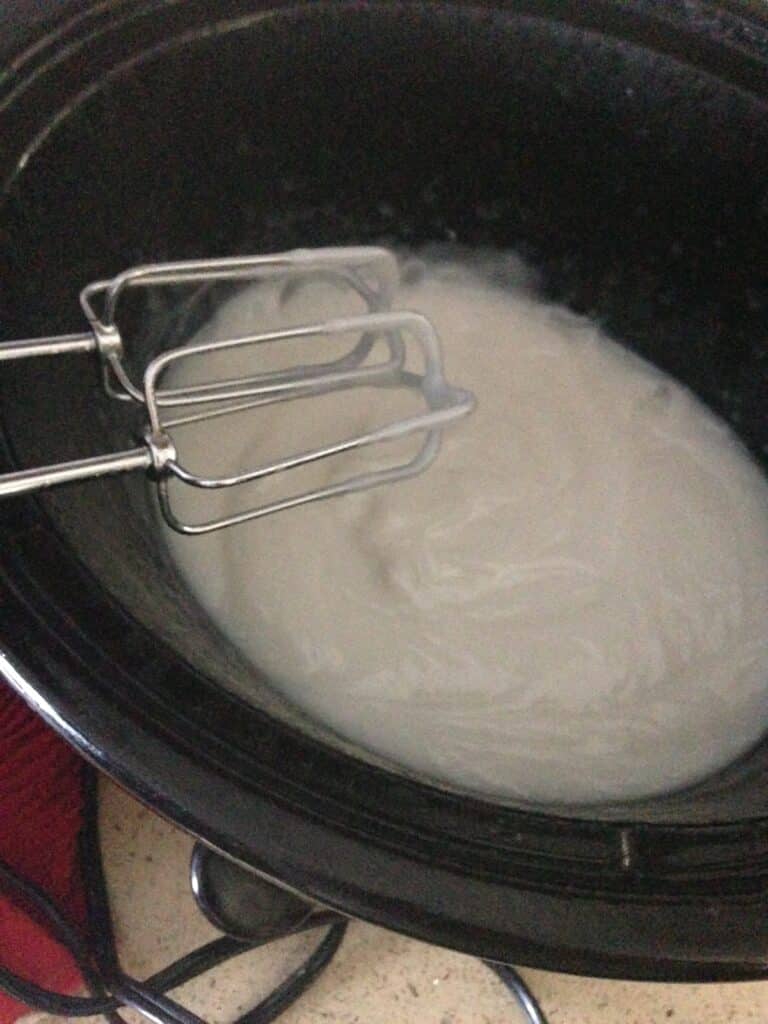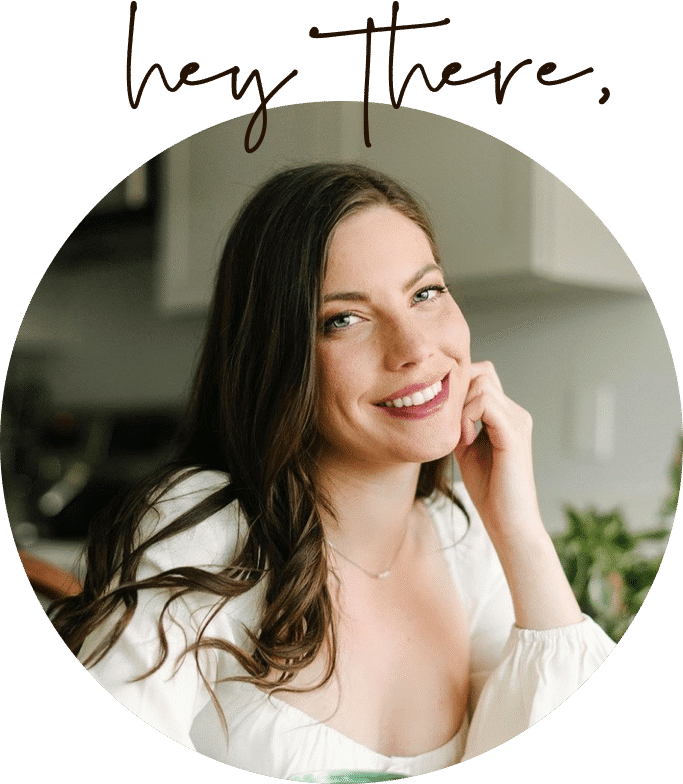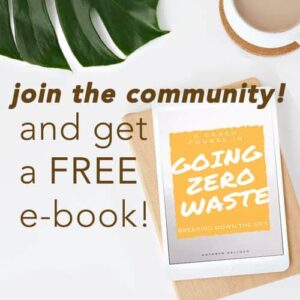Last Updated on June 29, 2023
This homemade shampoo bar recipe is so simple! A DIY shampoo bar is a healthy way to leave your hair clean and fresh without harming the planet.
Whether you are going on a camping trip or are spending time at home, learning how to make a shampoo bar is a great way to save on products. Making a shampoo bar at home is not only better for your hair, but it helps keep nasty chemicals out of the water too. You’ll love this shampoo bar recipe so much that you’ll never go back to store-bought shampoo!

Table of Contents
homemade bar shampoo
Alright, so this post has been a long time coming. You have searched and searched in my search bar for DIY soap and DIY shampoo bars, and I am finally delivering! So let’s talk about how to make a shampoo bar!
I have long, mostly straight, fairly dry, thick, and very fine hair. I live where there’s hard water. It’s much harder to use DIY soap bars in hard water than it is for those with soft water. Ditching shampoo can take some time to adjust to. There’s no one size fits all solution.
But, I was committed to making a shampoo bar work for me and I’m very happy with my decision! I love the results. My hair used to knot like crazy. I always struggled with huge amounts of tangling. Since switching to this shampoo bar recipe, I’m tangle free. My hair is smooth and silky!
I embedded it low res in the blog post to keep from slowing down the site — check it out on youtube for higher quality and HD.
why you’ll love this diy shampoo bar
- it’s an easy zero waste swap from bottled shampoo to homemade bar shampoo
- a diy shampoo bar is surprisingly easy to make
- can improve the silkiness of your hair
- makes a great gift idea
my experience with making a shampoo bar
To give you a representation of my experience with using DIY soap bars, I used to spend 10 minutes just brushing my hair in the morning. That’s how many tangles I had. After the swap to homemade bar shampoo, I now only spend maybe 30 seconds brushing. Life. Changing.
However, it still doesn’t hold curl very well… I’m experimenting with different hairsprays. I’ll let you know if I find one!
I used a hair wax in the video… hindsight, after seeing myself in the video, it was a mistake. Oops. But, I was NOT refilming. (And, I couldn’t bribe Justin with enough chocolate to spend another afternoon filming….) You live. You learn. Now I know you don’t try new stuff on the day you shoot a video.

This is what the soap looks like when it comes to trace. Like coconut pudding!
When crafting this recipe, I wanted to use as few ingredients as possible. I like to keep things MEGA simple. But, if you’re feeling adventurous, you can play around with soap calculations here.
tips for using homemade bar shampoo
1. Don’t rub the bar on your head. And, especially not in your crown. Rub the bar together in your hands. Create a nice lather and then apply to your head.
2. Avoid concentrating the soap on your crown. In fact, I’d recommend shampooing the crown last.
3. SCRUB! I mean scrub. Give yourself a nice scalp massage – at least two minutes. This is not like regular shampoo that’s just going to luxuriously fall out of your hair with just a shower stream.
4. Balance your pH. Acid rinse, baby. The natural grease level of your hair and whether you have soft or hard water will determine what type of acid and how often. I wash my hair once or twice a week and do the acid rinse once a week or every other week.
I like one tablespoon of vinegar diluted in a cup of water. More vinegar does not mean better — I learned the hard way! You will look like a grease pit. Just one tablespoon diluted in a cup of water is plenty.
5. Be prepared for a detox phase. Going from regular shampoo to a shampoo bar is different. You can read more about that on a no poo blog.
6. Massage your scalp. This has helped my hair so much. Before brushing your hair in the morning and before bed, massage your scalp for a minute or two to help redistribute the oil.
7. Invest in a boar bristle brush. At night, for 5 – 10 minutes, I brush my hair to redistribute the oils. This isn’t every night, but if I have some downtime and I’m watching tv or listening to music, I’ll brush my hair.

a note on lye
It’s really not that scary. Lye comes from wood ash. It was used as a cleaning agent for a long time in the middle ages and Renaissance. It is caustic; so, be careful.
There’s no need to freak out, though! Don’t drink it. Don’t use it with anything with aluminum, and don’t use it in a small and confined space. If it gets on you, brush it off and cleanse the area with running water.
And always make sure to keep the area well ventilated.
You cannot make soap without lye. You cannot do it. Without lye, all you have is fat. And you can’t clean with fat!
shampoo bar recipe

homemade shampoo bar ingredients
- 16.5 oz of coconut oil: bought in bulk at rainbow grocery or sold in glass mason jars.
- 2.72 oz of lye: bought in plastic #2. Needs to be 100% lye.
- 6.27 oz of water
how to make a shampoo bar
melt coconut oil
Dump your coconut oil into a Crockpot set to ‘low.’ It will melt fairly quickly, so keep an eye on it.
mix lye and water
Wear gloves for this step! Add water to a heat-resistant glass and slowly add the lye to the water as you stir. Continue mixing until the lye has dissolved completely. It will be cloudy at first, but it will clear up in a few minutes.
add lye mixture to coconut oil
Once your lye mixture is clear, add it to the coconut oil in the slow cooker. Give it a good mix, then using a hand mixer or immersion blender, bring the mixture to “trace.”
You’ll know it’s been brought to trace because will have the consistency of pudding — view the above photo for reference.
cook
Cook the mixture on low for about 45 minutes. Check on it every 15 minutes or so and give it a stir if the oils rise too far up the side. It’s normal for them to rise up and fall back into the mixture. This is the process of it transforming from oil into soap.
Check on it at 45 minutes to see if it’s done. It should look like thin but fluffy mashed potatoes.
harden and use
Spoon the mixture into your molds, then tap each mold a few times to work out any air bubbles. If needed, cut your shampoo bar before it gets too hard. If using individual molds, this is not an issue.
You can use your shampoo bar right away, but it will last longest if you allow it to cure for 24 hours and up to a couple of weeks.
I use this bar for everything! Shaving, shampoo, washing my face and my body… Even if you hate it for your hair, it’s still awesome for shaving. It’s nourishing and has an awesome lather.
So, don’t be discouraged! I’d say go for it.
faqs
what are the benefits of homemade shampoo bars?
Shampoo bars are amazing for traveling because you can’t spill them! They save money, take up less space in the shower, and have virtually no packaging waste. They’re truly an amazing zero waste swap for typical shampoo (or body wash!)
is this shampoo bar really healthier for your hair?
Yes! You’ll find information out there that says bar shampoo strips your hair of its natural oils and dries it out. However, especially with a homemade shampoo bar recipe, you’re in control of what goes in it! You can absolutely put nourishing ingredients in your bars of shampoo to keep them from stripping oils and damaging your hair.
I’d love to know what you love to use on your hair. Do you use a shampoo bar? Baking soda? Shampoo in bulk?
Also, let me know if you liked the video! Do you want to see more youtube?














Wow! That looks so easy! I have found plastic packaging/sticker free soap locally but it is pretty pricey. Guess I’ll be trying to make my own when I run out.
Yes! Same here. Either it’s cheap and I don’t like the ingredients or it’s super expensive.
It’s amazing to me that people can go without washing their hair everyday. I NEED to wash my hair daily. If I go even one day without washing it, my hair is a gross, oily, un-stylable mess. I am kinda jealous of the once or twice a week washers. 😉
I’m curious if you’ve detoxed? Everyone is different! So you totally could have and still have to wash it that often.
I have a bottle of lye I bought many months ago, and an old crock pot, to make my own soap and shampoo bars after I saw mommy pottomus make it.
I’ve been Washing my hair every other day for the past 18 months. I can’t use a lot of things on my hair because it makes my scalp crazy itchy so I’ve been rinsing with ACV, but I do it daily and it really helps. Maybe that’s too ofte, I’ll try cutting it down.
I love your blog, lots of great info you’re sharing!
Looks super easy! 🙂 But I dont understand why you would put something on your body that you wont touch during the process (lye)?
All soap is made from lye. The lye and fat go through a chemical process called saponification. Soaps are sodium or potassium salts of long chain fatty acids. When triglycerides in fat/oil react with aqueous NaOH or KOH, they are converted into soap and glycerol. This is called alkaline hydrolysis of esters. This reaction leads to soap. So, at the end you don’t have fat or lye – you have soap.
Thank you for your answer ?
Thank you so much for sharing this recipe. You mentioned adding a scent to it – how would you go about doing that?
You can add some essential oil after it comes out of the crock pot and before you let it harden.
Yipee! I made a batch and it came out well. So glad to be liberated from more expense and toxic stuff.
You can use citric acid for a hair rinse instead of vinegar.It comes in more planet-friendly packaging and you supply the water instead of buying the water in the vinegar at the store.
Thank you for that tip! I’m going to try too!
YAY! I’m so glad. 😀
Just watched your video. Great job! Again, can you clarify whether you use the "tools" that touch the lye on food, and if so, how do you make sure all the lye is gone? Thanks!
Put them in a vinegar bath and then wash with soap and water! The only utensil that won’t work for is a wooden spoon.
What is the vinegar/water rate of the solution you are using in your video?
Hi!
GREAT video! 🙂
I just found a recipe for a dishwasher detergent and one of the ingredients is grated coconut soap. Do you think I can make this soap, and then grate it?
Thanks!
(Also, it works with a normal pan and stove, right?)
I’m trying to decide how well this would work with curly hair. Boar’s bristle brushes are AWFUL on my hair, don’t get down to the scalp at all and just run along the surface doing no good. I also need hella moisturizing to make my hair manageable and not just a frizzball (I live in an extremely dry climate).
Neat! I have managed to leave all shampoo & hair soap behind– I wash with nothing but water. I used to be an "I have to wash every day or it gets greasy" person, but I found that if I gradually stretched time between washings, that problem went away. Lots of brushing and scalp massage keep my hair clean and not oily.
Once every month or two, I will apply an egg mask or rinse with vinegar. I’m much happier with my hair now than I ever was with shampoo.
Just curious if you notice your drains clogging or draining more slowly from the coconut oil?
No, it’s not oil anymore. After it saponifies, it’s soap.
can the coconut oil be substituted for any other oil (liquid oil)?
ox
No. if you want to use another oil, you’ll need to go to a soap calculator and find the new amount of water and lye you’ll need.
In my knowledge, different PH is needed for skin( neutral) and hair( weak acid). If this shampoo bar is for 4 things as all in one, what grade of ph is this?
Hello,
I am French and I love your blog.
For this recipe is it possible to add white clay (to remove the dandelions) is it necessary to change the dose of LYE in this case ? And I have no potcock is it possible to do it in a normal pan?
Is it possible to make this without a crockpot?
My 4 in 1 soap bar came out really hard as I was using my hand blender to mix the oil and lyeXliquid. I could hardly pack it into the mold. I admit I used goat milk instead of water. Could that be the cause? Any advice?
Thanks for the tips on washing without proper shampoo…it’s just what I was looking for! Im a big fan and always appreciate your insight. So I’m one week into using a handmade bar on my hair and then doing a vinegar rise. So far my hair is way greasy but I’m trying to tough it out. But I have a question! Do you rinse out the vinegar rinse? Or is that the last thing you do?
I have switched us to bar soap from liquid hand and body soap but I can’t get over how gross it can get. It will become soft and gooey on the bottom. Is there anything I can do to prevent this?
Get a magnetic soap holder, they’re fab.
getting a soap dish that allows aeration will help! the kind that his the little ridges of even ones with slats.
What’s the difference if I use cold pressed coconut oil and the coconut oil that came from cooking the coconut meat?
Hi Kathryn! Soap makers say that using only coconut oil can be harsh and drying for the skin. Do you still use this soap daily? How is it for you?
Anyway, i got the answer for my previous question from a soap maker. The bar soap using home made coconut oil has shorter shelf life.
Yay! I’ve been buying ingredients for this exact recipe and can’t wait to try. It was SUPER helpful to see the video- now I’m less terrified! And helpful to know approx.1 bar = 2 mos. Thank you!!!
Maybe this would just make more work for one person but I just read an article about making lye itself. Super interesting I think to at least do once. It seems rather simple enough. It’s just a matter of boiling the wood ash and combining it with animal fat.
A boar bristle brush. What a shame you’re not vegan.
We have an old fashioned lye bar of soap my husband brought home out of cataloochee. My curly hair hated it, but we used it in the tub until we bought some goat milk soap from a lady. Anyways I started using the lye soap for dishes, and they’re streak free and beautiful. I don’t think we’ll ever go back to dawn lmao.